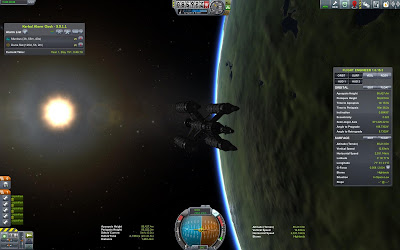However, one thing kept me musing: How on earth can a
crew survive a 2+ years-voyage mentally sane in a tight enviroment of a Mk1-cockpit, a 2-manned Mobile
Processing Lab and a 4-manned „Hitchhiker“ passenger module, or mayhap an even
smaller spaceship, and no gravity? Of course, you could probably assume that Kerbals could have
the ability to kind of hibernate at will. However, I find this a highly
unrealistic setup, and thus, against the spirit of this game, or, at least, how
I see and want to play this game.
The construction of a real long distance spacecraft is in
order. Kinetic gravity is in order. Enough living space is in order, this thing
will be home for my Kerbonauts for a very long time! Enough fuel and a barge for
Duna landings is in order. Even more things could be in order, if I had the
tech levels to do so, but let´s see what I can come up with right now…
… and such I spend two entire game sessions on diverse
construction attempts and different spaceship concepts, until this thing here emerges;
may I proudly present the „Omniscient“-class! A central Mobile Processing Lab
receives all data aquired during its long voyage and creates 100% transmittable
science points from it. Altogether five Hitchhiker passenger modules constitute the
living area; a central „dining hall“ and one private accomodation for each of
the intended crew of four (two scientists, a pilot and an engineer). As a
barge, an already pre-designed new lander vessel gets attached via a docking
port (not sure if Duna-able, but hey, it´s my first try ever!).
Once the new ship class is ready, though, I have to swallow
hard to actually follow through. Both the VAB and the launchpad need an upgrade
to the highest tier 3 in order to support the weight and part count. Scratch off
2 million credits. The ship itself, inclusive launch stage, costs a whopping
175,000 credits. Is it really worth it or just hopelessly overengineered? And I
am kind of broke now. Ah, screw it, this is fun!!!
As much fun as, say, trying to launch that baby to orbit?
Even more so than with the Scientia-class, designing the proper launch stage and
trying it out requires another full game session. The main problem turns out to
be the „cross-piece“ consisting of eight structural fuselages, which I use for role-playing reasons as „connection tubes“ to the outside „crew appartments“; the
top-weighted drag makes the rocket flip over once it gets too fast in the lower
atmosphere.
- uhm... maybe like this?
- nope, neither...
- maybe this one?
- looks good...
In the end, I finally have the Omniscient in orbit. A mix of initial raw booster power, slightly thrust limited, and carefully throttled "Skipper" engines finally achieves the right mix between little drag, but still sufficient vertical as well as horizontal speed, so that, after staging to the final configuration, the remaining feeble "Poodle" engines finally manage to circularize the ship in time before gravity´s tentacles can strike back. I am pretty sure that the launch would have been much more routine if I already had unlocked Mainsail engines, but such is my tech limitation at this point.
- nope, neither...
- maybe this one?
- looks good...
In the end, I finally have the Omniscient in orbit. A mix of initial raw booster power, slightly thrust limited, and carefully throttled "Skipper" engines finally achieves the right mix between little drag, but still sufficient vertical as well as horizontal speed, so that, after staging to the final configuration, the remaining feeble "Poodle" engines finally manage to circularize the ship in time before gravity´s tentacles can strike back. I am pretty sure that the launch would have been much more routine if I already had unlocked Mainsail engines, but such is my tech limitation at this point.
- orbit achieved!
The Omniscient in LKO. The mother of all ships so far. A mothership. I hope this investment will live long and prosper. A pity I did not have a station contract which would have financed its costs. My ideas for next session are to refill the voluminous fuel tanks via multiple spaceplane flights, bring all Kerbonauts to Minmus to land and plant flags (experience boost for everyone!), refuel as appropriate, stuff it with Minmus science data (for the crew to have something to do), and then finally send it on the required one-year trip to Duna (possibly even beyond?). If I am feeling bold I can even try to land it first on Mun and cash-in that Mun-outpost-contract on my list, to at least cover some of its costs! Wohoo!
The Omniscient in LKO. The mother of all ships so far. A mothership. I hope this investment will live long and prosper. A pity I did not have a station contract which would have financed its costs. My ideas for next session are to refill the voluminous fuel tanks via multiple spaceplane flights, bring all Kerbonauts to Minmus to land and plant flags (experience boost for everyone!), refuel as appropriate, stuff it with Minmus science data (for the crew to have something to do), and then finally send it on the required one-year trip to Duna (possibly even beyond?). If I am feeling bold I can even try to land it first on Mun and cash-in that Mun-outpost-contract on my list, to at least cover some of its costs! Wohoo!


































